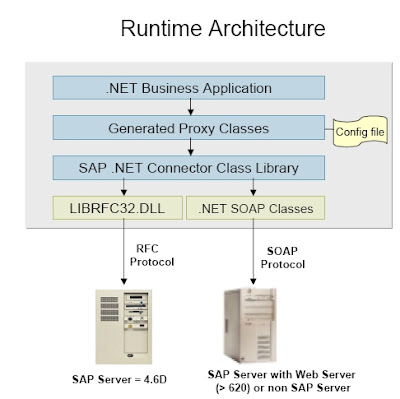Anyhow, the connector is made up of several parts. As I mentioned, first it’s pretty tightly integrated with Visual Studio for generating SAP proxies. The proxies are used to call BAPI functions through either the SAP RFC protocol (librfc32.dll) or via SOAP. Do note, per the documentation...Release 4.6D does not have SOAP support while systems starting from 6.20 can use either. At the moment, the most current version of the connector is built for .NET 2.0 (SAP Connector for Microsoft .NET 2.0). Additional dlls that are part of the assembly is the SAP.Connector.Rfc.dll and LibRfc.dll. (LIBRFC32.dll, is in Release 6.20 and higher). The diagram below, details the runtime architecture and how communication is facilitated using the .NET Connector.

2 comments:
Contrary to what is mentioned in this post, the SAP .NET Connector 2.0 still requires the .NET 1.1 framework. This also means that if you need to implement the ERP MA, you will first need to install VS 2003, as the SAP .NET Connector will check if this environment is installed. So, on an MIIS 2003 SP2/ILM 2007 installation, you will need to install both VS2003 and VS2005 (which is not a problem - multiple versions of VS can happily live together on the same system.
Paul Loonen.
Hi Paul,
Yes, you are correct. Thanks for detailing that which is important to note to anyone attempting to implement this type of connectivity.
Chris
Post a Comment